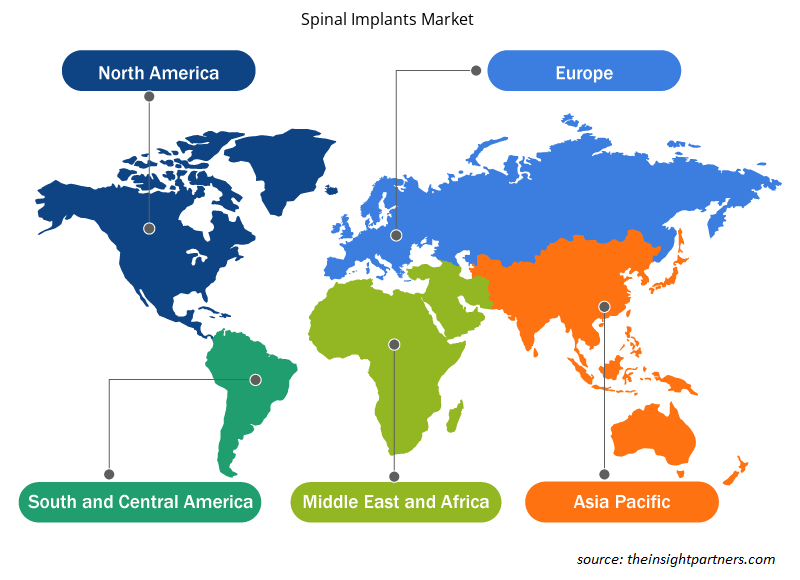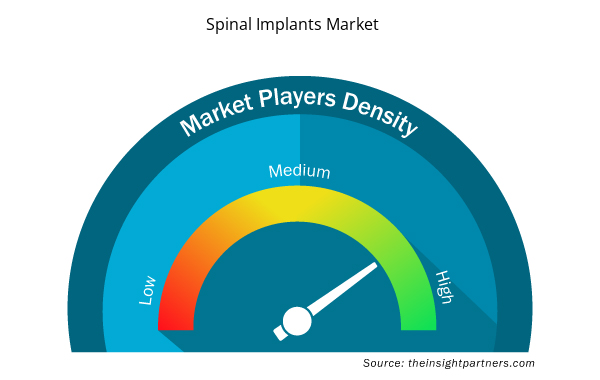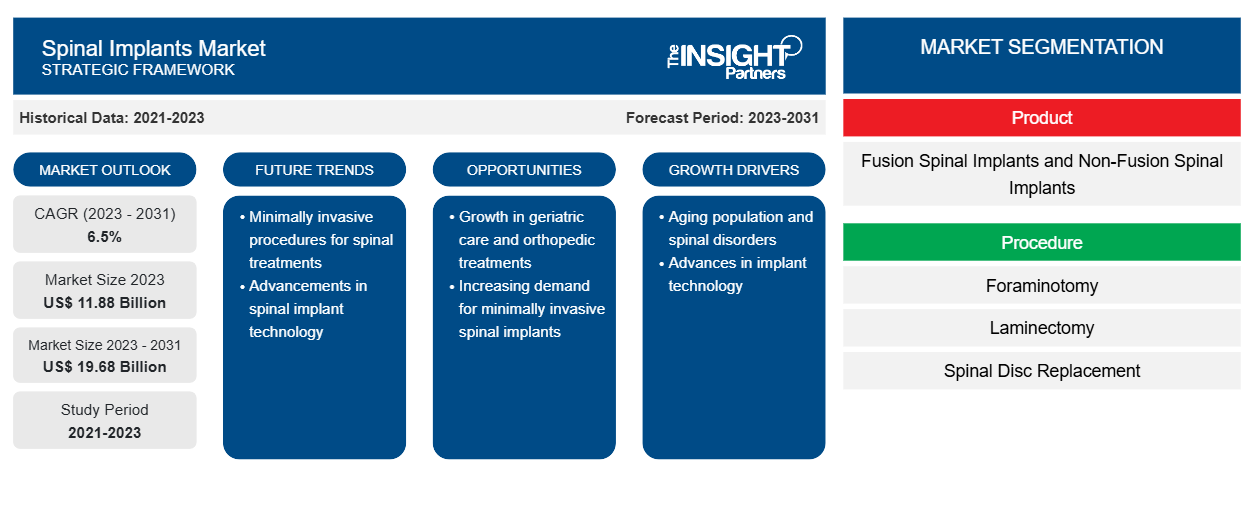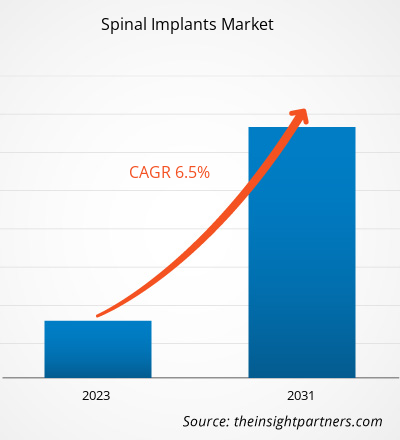[Informe de investigación] El pronóstico del mercado de implantes espinales puede ayudar a las partes interesadas en este mercado a delinear sus estrategias de crecimiento. Se proyecta que el mercado crecerá de US$ 11.88 mil millones en 2023 a US$ 19.68 mil millones en 2031; se estima que registrará una CAGR del 6,5% durante 2023-2031.
Perspectivas del mercado y opinión de analistas:
Los implantes espinales son dispositivos médicos que se utilizan en procedimientos de estabilización de la columna vertebral para fortalecerla, tratar deformidades y facilitar la fusión. Las lesiones de la columna vertebral generalmente son causadas por traumatismos o por vértebras desplazadas debido a discos intervertebrales degenerativos. Factores como el creciente número de procedimientos de implantes espinales y la creciente incidencia de traumatismos y lesiones relacionadas con el deporte impulsan el crecimiento del mercado de implantes espinales . Sin embargo, las estrictas regulaciones impiden el crecimiento del mercado. Se espera que la impresión 3D de implantes para procedimientos quirúrgicos traiga nuevas tendencias al mercado de implantes espinales en los próximos años.
Factores impulsores del crecimiento:
Aumento de la incidencia de traumatismos y lesiones relacionadas con el deporte
Las lesiones traumáticas, incluidas las causadas por accidentes y actividades deportivas, a menudo requieren intervenciones en la columna vertebral, incluido el uso de implantes para estabilización y reconstrucción. La creciente incidencia de lesiones traumáticas en la columna vertebral contribuye a la demanda de implantes espinales. Según la Organización Mundial de la Salud (OMS), a nivel mundial, aproximadamente 1,19 millones de personas mueren cada año en accidentes de tránsito, y entre 20 y 50 millones de personas sufren lesiones no fatales, y muchas sufren una discapacidad. De manera similar, según las estimaciones de la Clínica Mayo, los deportes y las actividades atléticas como el buceo en aguas poco profundas, el baloncesto y el fútbol causan aproximadamente el 10% de las lesiones de la médula espinal. Los datos de la OMS también sugieren que anualmente se registran entre 250.000 y 500.000 lesiones de la médula espinal (LME) en todo el mundo. Sin embargo, la mayoría de las lesiones de la médula espinal, incluidas las causadas por accidentes automovilísticos, caídas o agresiones, son prevenibles. Las personas que sufren LME tienen entre 2 y 5 veces más probabilidades de morir prematuramente que las que no las padecen, y los países de ingresos bajos y medios informan tasas de supervivencia notablemente más bajas. Por lo tanto, la creciente incidencia de traumatismos y lesiones relacionadas con el deporte genera una gran demanda de intervenciones quirúrgicas, lo que a su vez impulsa el crecimiento del mercado de implantes espinales.
Personalice este informe según sus necesidades
Obtendrá personalización en cualquier informe, sin cargo, incluidas partes de este informe o análisis a nivel de país, paquete de datos de Excel, así como también grandes ofertas y descuentos para empresas emergentes y universidades.
- Obtenga las principales tendencias clave del mercado de este informe.Esta muestra GRATUITA incluirá análisis de datos, desde tendencias del mercado hasta estimaciones y pronósticos.
Segmentación y alcance del informe:
El análisis del mercado de implantes espinales se ha realizado considerando los siguientes segmentos: producto, procedimiento, material y usuario final.
Por producto, el mercado se divide en implantes espinales de fusión e implantes espinales sin fusión. El segmento de implantes espinales de fusión tuvo una participación de mercado de implantes espinales más grande en 2023. Se anticipa que registre una CAGR más alta durante el período de pronóstico. El mercado del segmento de implantes espinales de fusión se subdivide en dispositivos toracolumbares, dispositivos de fijación cervical y dispositivos de fusión intercorporal.
El mercado, por procedimiento, se clasifica en foraminotomía, laminectomía, reemplazo de disco espinal, fusión espinal y discectomía. El segmento de laminectomía tuvo la mayor participación de mercado de implantes espinales en 2023, y se estima que la fusión espinal registrará la CAGR más alta durante el período de pronóstico.
El mercado de implantes espinales, por material, está segmentado en titanio, fibra de carbono y acero inoxidable . El segmento de acero inoxidable tuvo la mayor participación de mercado en 2023; se prevé que registre la CAGR más alta durante el período de pronóstico.
El mercado de implantes espinales, por usuario final, se clasifica en hospitales, centros de diagnóstico e imágenes, entre otros. El segmento de hospitales tuvo la mayor participación de mercado en 2023. Además, se espera que registre la CAGR más alta durante el período de pronóstico.
Análisis regional:
El alcance geográfico del informe de mercado de implantes espinales incluye América del Norte, Europa, Asia Pacífico, América del Sur y Central, y Oriente Medio y África. En 2023, América del Norte tenía la mayor participación de mercado. La creciente adopción de los últimos dispositivos médicos, la alta prevalencia de lesiones espinales y las innovaciones de productos por parte de actores clave contribuyen a la expansión del tamaño del mercado de implantes espinales en América del Norte. Según la Clínica Cleaveland, EE. UU. informa aproximadamente 18 000 nuevos casos de lesiones traumáticas de la médula espinal cada año, lo que equivale a aproximadamente 54 casos por millón de habitantes. Además, el desgaste relacionado con la edad desencadena la prevalencia del dolor lumbar (LBP) entre la población geriátrica en EE. UU., lo que a su vez impulsa la demanda de cirugías espinales y dispositivos implantables. Según los Servicios Nacionales de Salud, en 2022, se informa que la incidencia de por vida del LBP en EE. UU. es del 60 al 90 %, con una incidencia anual del 5 %. La fuente también afirma que el 14,3% de los nuevos pacientes visitan al médico cada año debido al LBP, y aproximadamente 13 millones de personas visitan al médico debido al LBP crónico. Por lo tanto, la alta prevalencia de lesiones de la médula espinal y LBP favorece el progreso del mercado de implantes espinales.
Perspectivas regionales del mercado de implantes espinales
Los analistas de Insight Partners explicaron en detalle las tendencias y los factores regionales que influyen en el mercado de implantes espinales durante el período de pronóstico. Esta sección también analiza los segmentos y la geografía del mercado de implantes espinales en América del Norte, Europa, Asia Pacífico, Oriente Medio y África, y América del Sur y Central.

- Obtenga datos regionales específicos para el mercado de implantes espinales
Alcance del informe de mercado sobre implantes espinales
| Atributo del informe | Detalles |
|---|---|
| Tamaño del mercado en 2023 | US$ 11.88 mil millones |
| Tamaño del mercado en 2031 | US$ 19,68 mil millones |
| CAGR global (2023 - 2031) | 6,5% |
| Datos históricos | 2021-2023 |
| Período de pronóstico | 2023-2031 |
| Segmentos cubiertos | Por producto
|
| Regiones y países cubiertos | América del norte
|
| Líderes del mercado y perfiles de empresas clave |
|
Densidad de actores del mercado de implantes espinales: comprensión de su impacto en la dinámica empresarial
El mercado de implantes espinales está creciendo rápidamente, impulsado por la creciente demanda de los usuarios finales debido a factores como la evolución de las preferencias de los consumidores, los avances tecnológicos y una mayor conciencia de los beneficios del producto. A medida que aumenta la demanda, las empresas amplían sus ofertas, innovan para satisfacer las necesidades de los consumidores y aprovechan las tendencias emergentes, lo que impulsa aún más el crecimiento del mercado.
La densidad de actores del mercado se refiere a la distribución de las empresas o firmas que operan dentro de un mercado o industria en particular. Indica cuántos competidores (actores del mercado) están presentes en un espacio de mercado determinado en relación con su tamaño o valor total de mercado.
Las principales empresas que operan en el mercado de implantes espinales son:
- Corporación Stryker
- Johnson y Johnson
- Globus Medical Inc
- ZimVie Inc
- Tecnologías de columna vertebral Camber LLC
Descargo de responsabilidad : Las empresas enumeradas anteriormente no están clasificadas en ningún orden particular.

- Obtenga una descripción general de los principales actores clave del mercado de implantes espinales
Desarrollos industriales y oportunidades futuras:
A continuación se enumeran algunos desarrollos estratégicos de los principales actores que operan en el mercado de implantes espinales, según comunicados de prensa de la empresa:
- En octubre de 2023, Silony Medical International AG completó la adquisición del negocio de fusión global de Centinel Spine. A través de esta adquisición, Silony logra una entrada importante en el mercado estadounidense y fortalece significativamente su oferta de jaulas independientes anteriores.
- En septiembre de 2023, Globus Medical Inc completó su fusión con NuVasive Inc. La empresa combinada ofrece a los cirujanos y pacientes una de las soluciones de procedimientos musculoesqueléticos más completas, lo que permite avances tecnológicos en todo el proceso de atención.
- En noviembre de 2022, NuVasive Inc. anunció el lanzamiento comercial del sistema de tubos NuVasive (NTS) y Excavation Micro, una revolucionaria tecnología de cirugía mínimamente invasiva (MIS) que ofrece soluciones completas para la fusión intercorporal lumbar transforaminal (TLIF) y la descompresión. Con las incorporaciones a la cartera de NuVasive P360, la empresa mejoró sus capacidades tecnológicas de acceso e instrumentación.
- En agosto de 2022, Nexus Spine anunció el lanzamiento comercial completo de su sistema de fijación lumbar posterior PressON. Las varillas PressON están diseñadas para presionar sobre tornillos pediculares en lugar de tornillos de fijación. Este diseño único, biomecánicamente más resistente, mide aproximadamente una cuarta parte del tamaño de los sistemas estándar. Las varillas se implantan más rápido y evitan la posibilidad de que se aflojen los tornillos de fijación y permiten el montaje intraoperatorio de las varillas para los pacientes. El lanzamiento completo al mercado permitió a la empresa ampliar su cartera basada en mecanismos compatibles, que incluye una gama de dispositivos de fusión intercorporal de titanio Tranquil flexibles que se ofrecen después de un exhaustivo período de validación de mejoras y refinamientos del sistema.
- En octubre de 2021, NuVasive Inc lanzó el implante Cohere TLIF-O. Con la incorporación del implante Cohere TLIF-O a su cartera de productos de Ciencia de materiales avanzados (AMS), NuVasive se ha convertido en la única empresa que ofrece implantes de titanio poroso y de PEEK poroso para cirugía de columna posterior.
Panorama competitivo y empresas clave:
Stryker Corporation, Johnson & Johnson, Globus Medical Inc, ZimVie Inc, Camber Spine Technologies LLC, Spineart SA, Medtronic plc, Orthofix US LLC, ATEC Spine Inc y B. Braun SE se encuentran entre las empresas destacadas que aparecen en el informe sobre el mercado de implantes espinales. Estas empresas se centran en el desarrollo de nuevas tecnologías, la mejora de los productos existentes y la expansión de su presencia geográfica para satisfacer la creciente demanda de los consumidores en todo el mundo.
- Análisis histórico (2 años), año base, pronóstico (7 años) con CAGR
- Análisis PEST y FODA
- Tamaño del mercado Valor/volumen: global, regional, nacional
- Industria y panorama competitivo
- Conjunto de datos de Excel


- Point of Care Diagnostics Market
- Underwater Connector Market
- Integrated Platform Management System Market
- Legal Case Management Software Market
- Grant Management Software Market
- Vaginal Specula Market
- Green Hydrogen Market
- Environmental Consulting Service Market
- Sweet Potato Market
- Portable Power Station Market

Report Coverage
Revenue forecast, Company Analysis, Industry landscape, Growth factors, and Trends

Segment Covered
This text is related
to segments covered.

Regional Scope
North America, Europe, Asia Pacific, Middle East & Africa, South & Central America

Country Scope
This text is related
to country scope.
Preguntas frecuentes
The spinal implants market, by end user, is categorized into hospitals, diagnostic and imaging centers, and others. The hospitals segment held the largest market share in 2023. It is further expected to register the highest CAGR during the forecast period.
The spinal implants market, by material, is segmented into titanium, carbon fiber, and stainless steel. The stainless steel segment held the largest market share in 2023; it is anticipated to register the highest CAGR during the forecast period.
The market, by procedure, is categorized into foraminotomy, laminectomy, spinal disc replacement, spine fusion, and discectomy. The laminectomy segment held the largest spinal implants market share in 2023, and spine fusion is further estimated to register the highest CAGR during the forecast period.
The spinal implants market is expected to be valued at US$ 19.68 billion in 2031.
By product, the market is bifurcated into fusion spinal implants and non-fusion spinal implants. The fusion spinal implants segment held a larger spinal implants market share in 2023. It is anticipated to register a higher CAGR during the forecast period.
The spinal implants market was valued at US$ 11.88 billion in 2023.
Factors such as surging number of spinal implant procedures and rising incidence of trauma and sport-related injuries propel the spinal implants market growth.
The spinal implants market majorly consists of the players, including Stryker Corporation, Johnson & Johnson, Globus Medical Inc, ZimVie Inc, Camber Spine Technologies LLC, Spineart SA, Medtronic plc, Orthofix US LLC, ATEC Spine Inc, and B. Braun SE.
Spinal implants are medical devices used in spine stabilization procedures to stabilize and strengthen the spine, treat deformity, and facilitate fusion. The spine injuries are generally caused by trauma or by slipped vertebrae due to degenerative intervertebral disks.
Trends and growth analysis reports related to Life Sciences : READ MORE..
The List of Companies - Spinal Implants Market
- Stryker Corporation
- Johnson & Johnson
- Globus Medical Inc
- ZimVie Inc
- Camber Spine Technologies LLC
- Spineart SA
- Medtronic plc
- Orthofix US LLC
- ATEC Spine Inc
- B. Braun SE
The Insight Partners performs research in 4 major stages: Data Collection & Secondary Research, Primary Research, Data Analysis and Data Triangulation & Final Review.
- Data Collection and Secondary Research:
As a market research and consulting firm operating from a decade, we have published and advised several client across the globe. First step for any study will start with an assessment of currently available data and insights from existing reports. Further, historical and current market information is collected from Investor Presentations, Annual Reports, SEC Filings, etc., and other information related to company’s performance and market positioning are gathered from Paid Databases (Factiva, Hoovers, and Reuters) and various other publications available in public domain.
Several associations trade associates, technical forums, institutes, societies and organization are accessed to gain technical as well as market related insights through their publications such as research papers, blogs and press releases related to the studies are referred to get cues about the market. Further, white papers, journals, magazines, and other news articles published in last 3 years are scrutinized and analyzed to understand the current market trends.
- Primary Research:
The primarily interview analysis comprise of data obtained from industry participants interview and answers to survey questions gathered by in-house primary team.
For primary research, interviews are conducted with industry experts/CEOs/Marketing Managers/VPs/Subject Matter Experts from both demand and supply side to get a 360-degree view of the market. The primary team conducts several interviews based on the complexity of the markets to understand the various market trends and dynamics which makes research more credible and precise.
A typical research interview fulfils the following functions:
- Provides first-hand information on the market size, market trends, growth trends, competitive landscape, and outlook
- Validates and strengthens in-house secondary research findings
- Develops the analysis team’s expertise and market understanding
Primary research involves email interactions and telephone interviews for each market, category, segment, and sub-segment across geographies. The participants who typically take part in such a process include, but are not limited to:
- Industry participants: VPs, business development managers, market intelligence managers and national sales managers
- Outside experts: Valuation experts, research analysts and key opinion leaders specializing in the electronics and semiconductor industry.
Below is the breakup of our primary respondents by company, designation, and region:

Once we receive the confirmation from primary research sources or primary respondents, we finalize the base year market estimation and forecast the data as per the macroeconomic and microeconomic factors assessed during data collection.
- Data Analysis:
Once data is validated through both secondary as well as primary respondents, we finalize the market estimations by hypothesis formulation and factor analysis at regional and country level.
- Macro-Economic Factor Analysis:
We analyse macroeconomic indicators such the gross domestic product (GDP), increase in the demand for goods and services across industries, technological advancement, regional economic growth, governmental policies, the influence of COVID-19, PEST analysis, and other aspects. This analysis aids in setting benchmarks for various nations/regions and approximating market splits. Additionally, the general trend of the aforementioned components aid in determining the market's development possibilities.
- Country Level Data:
Various factors that are especially aligned to the country are taken into account to determine the market size for a certain area and country, including the presence of vendors, such as headquarters and offices, the country's GDP, demand patterns, and industry growth. To comprehend the market dynamics for the nation, a number of growth variables, inhibitors, application areas, and current market trends are researched. The aforementioned elements aid in determining the country's overall market's growth potential.
- Company Profile:
The “Table of Contents” is formulated by listing and analyzing more than 25 - 30 companies operating in the market ecosystem across geographies. However, we profile only 10 companies as a standard practice in our syndicate reports. These 10 companies comprise leading, emerging, and regional players. Nonetheless, our analysis is not restricted to the 10 listed companies, we also analyze other companies present in the market to develop a holistic view and understand the prevailing trends. The “Company Profiles” section in the report covers key facts, business description, products & services, financial information, SWOT analysis, and key developments. The financial information presented is extracted from the annual reports and official documents of the publicly listed companies. Upon collecting the information for the sections of respective companies, we verify them via various primary sources and then compile the data in respective company profiles. The company level information helps us in deriving the base number as well as in forecasting the market size.
- Developing Base Number:
Aggregation of sales statistics (2020-2022) and macro-economic factor, and other secondary and primary research insights are utilized to arrive at base number and related market shares for 2022. The data gaps are identified in this step and relevant market data is analyzed, collected from paid primary interviews or databases. On finalizing the base year market size, forecasts are developed on the basis of macro-economic, industry and market growth factors and company level analysis.
- Data Triangulation and Final Review:
The market findings and base year market size calculations are validated from supply as well as demand side. Demand side validations are based on macro-economic factor analysis and benchmarks for respective regions and countries. In case of supply side validations, revenues of major companies are estimated (in case not available) based on industry benchmark, approximate number of employees, product portfolio, and primary interviews revenues are gathered. Further revenue from target product/service segment is assessed to avoid overshooting of market statistics. In case of heavy deviations between supply and demand side values, all thes steps are repeated to achieve synchronization.
We follow an iterative model, wherein we share our research findings with Subject Matter Experts (SME’s) and Key Opinion Leaders (KOLs) until consensus view of the market is not formulated – this model negates any drastic deviation in the opinions of experts. Only validated and universally acceptable research findings are quoted in our reports.
We have important check points that we use to validate our research findings – which we call – data triangulation, where we validate the information, we generate from secondary sources with primary interviews and then we re-validate with our internal data bases and Subject matter experts. This comprehensive model enables us to deliver high quality, reliable data in shortest possible time.


 Obtenga una muestra gratuita de este informe
Obtenga una muestra gratuita de este informe